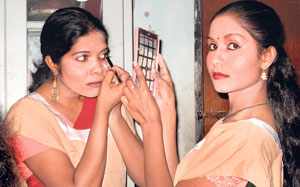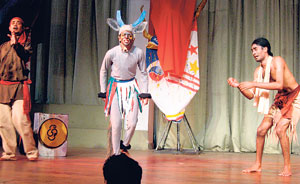I hesitated for some days before I could conjure up the courage to call Parakrama Niriella, a director I have admired and respected from the day I saw Varenthu as a teenager in the Sarachchandra Open Air Theatre. I wanted to meet him to discuss his experiences as one of the first members of the Wayside and Open Theatre and to talk of his recollections about working with the late Gamini Haththotuwegama, the pioneer of wayside theatre. At that time, I had no idea that through Niriella and Jana Karaliya, I would embark on yet another adventurous theatrical journey.
On October 14, I went to Chitra Villa to watch Jana Karaliya rehearse their latest play, Meti Karaththaya. It was the first time that I was able to observe a theatre group in residence. While I watched them rehearse, I had the chance to converse with several group members.
For some of them, Jana Karaliya had provided a space to establish contact with people of other ethnicities for the first time. They asserted that it was through their experience in Jana Karaliya that they were able to question and reconsider their preconceived stereotypes about members of the Sinhala or Tamil communities. Some even told me that they thought of the other community as the enemy before they became a part of Jana Karaliya. It is precisely these sorts of transformative moments that make the work of Jana Karaliya so significant to our country today.
The visit that day ended with me agreeing to join the group for their performance in Monaragala on October 22 and 23. The night before the trip, I stayed with them in their lodge and got to know some of them better. Since everyone was very welcoming and friendly it did not take long to feel at home. While serving Ajanthan’s spicy chicken curry and rice, Malithi explained that a number of them preferred to cook while others brought food from outside. Malithi and Ruvini had to share a bed because Ruvini offered hers to me.
That night, Chitra Villa was overflowing with activity: everyone getting their costumes together, ironing clothes, stitching ones that were torn, and making sure that all the props and equipment were ready. Inoka – amma, as the other members jokingly address her – presided over all the activities. She and Nishantha made sure that all was in order.
On the morning of the 22nd we woke up to find out that there was a water shortage. As a result, we had to use the well at the end of the garden around 4.30 a.m. The day that started with a premonition in some sense of the water shortage caused by the drought in Monaragala – continued with an eight-hour drive. During the journey, I got the opportunity to connect with several more members of the group.
Malkanthi asked me to guess whether she was Tamil or Sinhalese; I said she must be both and she in fact was. “Ranjith is my brother,” she told me; Ranjith too has mixed parentage. “We are neither seen as Sinhalese nor Tamil,” she told me laughingly.
These two young performers are a reminder of the more complex and nuanced truths of Sri Lankan ethnicity that are often oversimplified in the respective nationalist rhetorics.
Malkanthi’s story is an extremely empowering one. She spoke of the way in which many women in the plantation areas are confined to their houses and not allowed an education. Her parents, however, were open-minded and made sure that she went to school. Jana Karaliya was a space that enabled her to develop her creative abilities in various aspects of performing.
We arrived in Monaragala around 2 p.m. The weather was blazing hot and extremely dry. Until then, I had not realized that the group set up their light and sound system themselves. The night’s performance was a treat. Since the enclosed audience area with chairs and a canopy was bursting with people, spectators had to gather around outside the tent as well. One of the audience members caught my eye – a woman most likely in her 80s. Despite the fact that she needed help even to walk about, she stayed for the duration of the entire play.
The play started with a song and then Charandas and the policeman came running in. The audience was already intensely focused on the play. The way the group managed to manoeuvre the small performance area (which in fact reminded me very much of the front porch of a house) with ease was commendable. In order to compensate for the single door which functioned as the entrance and exit location, they made creative use of the outside audience area to enter the performing space. I was not aware that Charandas hides among the audience in the final scene and thus was able to savour that moment with the other spectators.
The second performance in Monaragala was at the Dutugamunu Maha Vidyalaya. The audience was packed, ranging from 6- year- olds to 80-year-olds. I sat among the enthusiastic spectators and noticed that the rain that came down did nothing to disperse them. The gentleman next to me, a banker, wanted to know all about Jana Karaliya. He of course knew Niriella’s work and expressed a desire to understand the purpose of the group.
Theatre in Sri Lanka is largely concentrated in the cities, mainly in Colombo and it is rarely that plays travel to other destinations in the country-especially to a location such as Monaragala. One of the statements that Haththotuwegama made repeatedly is that people in far away areas – that is far away in relation to the commercial capital – desire to see plays too, but it is only on exceptional occasions that plays produced in the cities are taken to rural areas.
Parakrama Niriella on several occasions has spoken about how his conception of the performance space evolved as a result of working with Haththotuwegama and the Wayside and Open Theatre. He and H.A. Perera, the founding members of Jana Karaliya, were part of the first street theatre group in Sri Lanka whose purpose was to take theatre beyond the proscenium stage to villages and other areas hitherto unfrequented by mainstream theatre.
It was inspiring to see Jana Karaliya involved in such an activity, where they in fact take theatre to locations away from the main cities and create an opportunity for people everywhere to watch and enjoy theatre. Many of the group members affirmed that they often get large and enthusiastic audiences and that once in Badulla they had to perform the same show six times on a single day because there was a never-ending stream of people arriving to see the play. In Monaragala too there was a large and eager audience that responded actively to the play. They were engaged in the performance and did not hesitate to comment on the specific acts and the characters as the play went on.
Jana Karaliya is a powerful space for several reasons. Many people who decide to work on ethnic solidarity resort to the idea of making work about war or peace. I would not discard that sort of art, but there is much to be said about the merits of a project such as this, one where members of the Sinhala and Tamil communities actually live together and create powerful art in both languages.
The praxis, the act of the creation itself is the moment of establishing that understanding or solidarity. Often when the cast and crew members go around introducing themselves after their performances, there is a moment of surprise in the audience and curious whispers about the identity of a specific performer.
Jana Karaliya is an empowering and creative space for the group members and and an inspiring space for audience members. I am glad I made that call! |


